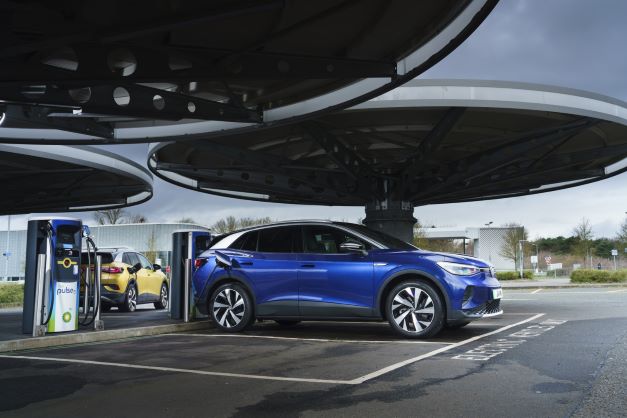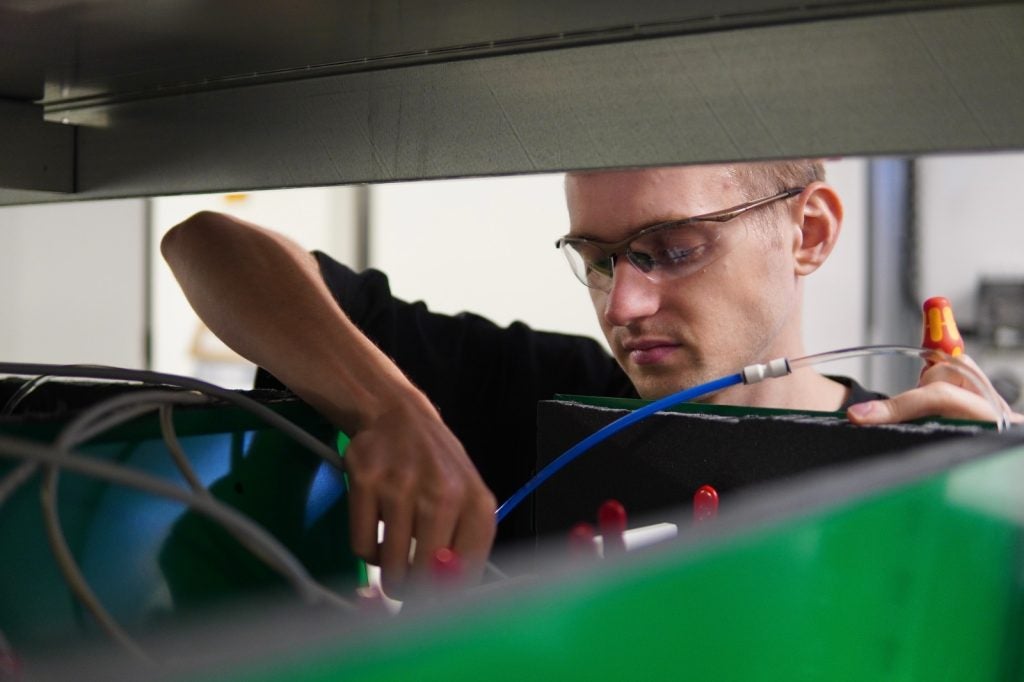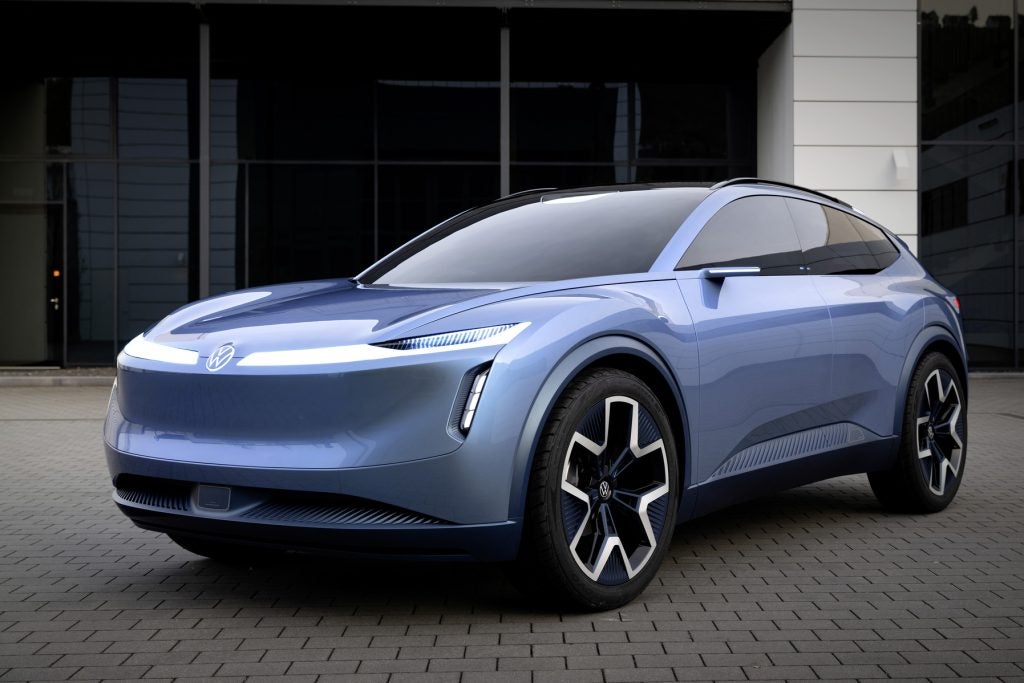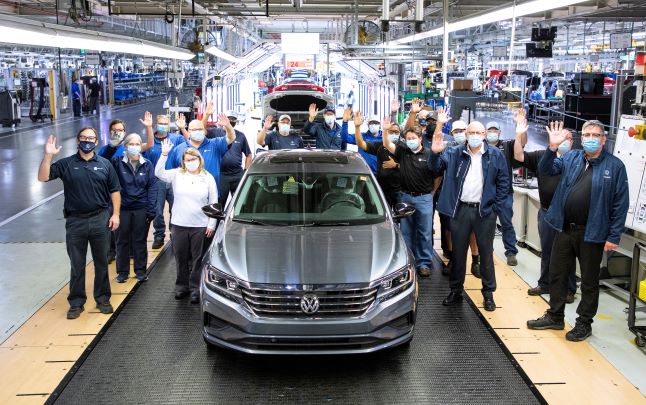
Inside story
The cabin is light and airy, partly thanks to its minimalist dashboard and expansive windscreen. Funky-coloured ambient lighting strips help to accentuate the armrests in the doors and upper area of the dash panel. The front section of the dash drops down towards the interior in steps, while decorative trim separates the top and bottom halves. The panoramic roof accentuates the sense of spaciousness.
All controls – including those on the steering wheel – are operated using touch-sensitive buttons. Only the electric windows, door mirrors and hazard warning lights are operated using conventional tactile switches. The chunky drive thumb-lever selector behind the steering wheel is simplicity itself; twist clockwise to move forward, anti-clockwise to reverse. A benefit of the small column-mounted gauge cluster is that when you adjust the steering wheel, it doesn’t block the view of the cluster as they move together.
The capacitive touch points located at the base of the touchscreen – to control the car radio volume and temperature – are not backlit during night-time driving, however. The volume can also be operated using steering wheel thumbpads. Drivers can also use their voice to adjust the temperature.
Size-wise, the ID.4 measures 4,584 mm long, 1,852 mm wide and 1,640 high. The net result leaves plenty of room for six-footers sitting in the back on cinema-style seats, i.e. positioned slightly higher than the front.
Storage-wise, the boot can swallow 543 litres of luggage (including an underfloor stowage area for the two charging cables), and its volume can grow to 1,575 litres by folding down the split rear seat backrest. The lidded centre console storage area is long and wide with dividers that can be removed and reconfigured to suit. Two further cupholders are situated in front of that. The door bins are deep and flock-lined to avoid things clattering around.
How well do you really know your competitors?
Access the most comprehensive Company Profiles on the market, powered by GlobalData. Save hours of research. Gain competitive edge.

Thank you!
Your download email will arrive shortly
Not ready to buy yet? Download a free sample
We are confident about the unique quality of our Company Profiles. However, we want you to make the most beneficial decision for your business, so we offer a free sample that you can download by submitting the below form
By GlobalDataIn the back, there is a similar amount of legroom to a Tiguan Allspace, while the headroom for all five-passengers is slightly better too. The flat floor means three people can sit quite comfortably in the back. The back of each front seat incorporates a magazine holder in the lower half and a phone pouch in the top half. That’s another neat idea.
Interior lighting
Taking the form of a wide yet narrow 54-LED strip beneath the windscreen, VW’s ‘ID. Light’ aims to assist the driver. Once seated, the system signals that the ID.4 is ready to drive. On the move and when the car is due to make a turn, following a route planned into the navigation system, the light moves to the left or right end of the strip accordingly. Having linked your phone to the car, when receiving a phone call, the strip will flash green. And while the car is charging, a green bar builds up from left to right representing the level of battery charge to see the status from a distance. Although such ‘look at this’ innovations feel a little quirky, they help it stand out in a rapidly growing electric SUV marketplace.
Augmented reality head-up display
An optional augmented reality (AR) head-up display (HUD) projects vehicle information such as its speed onto the windscreen in front of the driver with, for instance, the turn arrows of the navigation system also displayed as they become relevant. However, the driver sees the information as a 3D staggered image at an apparent distance of around three to ten metres in front of the vehicle. This means that the display appears to be integrated into the real world outside the car. When adaptive cruise control or travel assist is active, any vehicle in front of the ID.4 is, from a certain speed, highlighted by the AR HUD with a luminous marking.
Voice control
Voice control also plays its part in the ID.4. The driver and front-seat passengers can give instructions such as “Hello ID, I’m cold” to turn up the heating or “Hello ID, play Radio 2” to switch the infotainment system to the corresponding station. The panoramic roof sunblind can also be operated by voice control. It can be a little glitchy though.
Connectivity
The ID.4’s Online Connectivity Unit brings the online services of We Connect Start into the car. Highlights of We Connect Start include navigation and a variety of vehicle-related services. The Online Traffic Information services provide the driver with details of the situation on the selected route at any one point, along with any potential hazards. Meanwhile, the Charging Stations service offers live data on available charge points in the vicinity. It provides details on their charging capacity, as well as tariff costs.
Advanced driver assistance systems
A number of driver assistance systems are fitted to the ID.4 under the IQ. Drive umbrella designation. They include a front radar sensor, a front camera, two rear radar sensors and eight ultrasound sensors to monitor the area around the car.
As part of the Assistance “Plus” package, Travel Assist bundles together features and functions more commonly seen in the luxury car class. This system largely takes over acceleration and braking from the driver at any speed and also helps to keep the ID.4 in its lane by appropriate steering interventions (within system limits). The driver has to lightly touch the capacitive steering wheel to keep the adaptive lane guidance active. Adaptive cruise control with a speed limiter is also integrated into Travel Assist.
Eco Assistance is another standard-fit system on the ID.4. It evaluates the navigation data and the road signs detected by the forward-facing camera and, if the ID.4 is approaching a bend or a town boundary, for example, the system can visually indicate when to lift off the accelerator. This simple yet complex calculation allows the car’s drive system to perform optimum energy recuperation, thereby supporting optimal range performance.
Other ADAS functions include lane assist (to help prevent the car from unintentionally crossing lane markers on the road), emergency assist (attempts to alert or wake the driver by steering jerks and, if this fails to generate a response, an emergency stop is initiated), side assist (monitors traffic behind the car with the aid of the car’s rear radar systems, specifically targeting ‘blind spots’) and front assist. The latter monitors the area in front of the car using a camera. It reacts to potential imminent collisions via warnings and, if required, braking interventions. Meanwhile, the ID.4’s oncoming vehicle braking when turning function monitors the opposite lane when turning off, issuing a warning and/or braking the car automatically if it anticipates an emergency. Swerve support helps the driver to navigate obstacles in the road by providing the corresponding steering interventions, and to avoid minor parking collisions, the standard audible park distance control has an integrated manoeuvre braking system. The rearview camera incorporates a high-pressure jet that can be activated if it gets dirty.
On the road
Current top-sellers in the ID.4 range are the Pro Performance powertrain, Life specification and 77 kWh battery option. Our Pro Performance, with 77 kWh and 204 PS provided an actual range of 280 miles fully charged on a chilly day. The battery can be recharged to around 80 per cent in just under an hour using a 100kW charger while a full charge takes about nine hours using a 7kW domestic wall box. Its tight turning circle is helpful in town and manoeuvring around multi-story car parks.
On balance, the seriously spacious interior of the ID.4 ticks a lot of boxes. Although its minimalist dash means adjusting the HVAC settings and audio via a large ten-inch touchscreen, the graphics are sharp and responsive. Its clean, futuristic cockpit doesn’t offend. There is no start button. Once seated, the ID.4 powers on and is ready to drive. When you climb out, it powers down and chimes a chirpy tune to confirm that the vehicle is switched off. There is very little not to like about this compelling all-electric SUV.
ID.4 production is underway in Zwickau, Germany, and two plants in China (Anting and Foshan). Production in Chattanooga, US, is expected to start next year alongside a second German plant in Emden. UK market cars are manufactured in Zwickau, a factory powered by renewable energy. Rivals for the ID.4 include the Hyundai Ioniq 5, Kia EV6 and Ford Mustang Mach-E.







